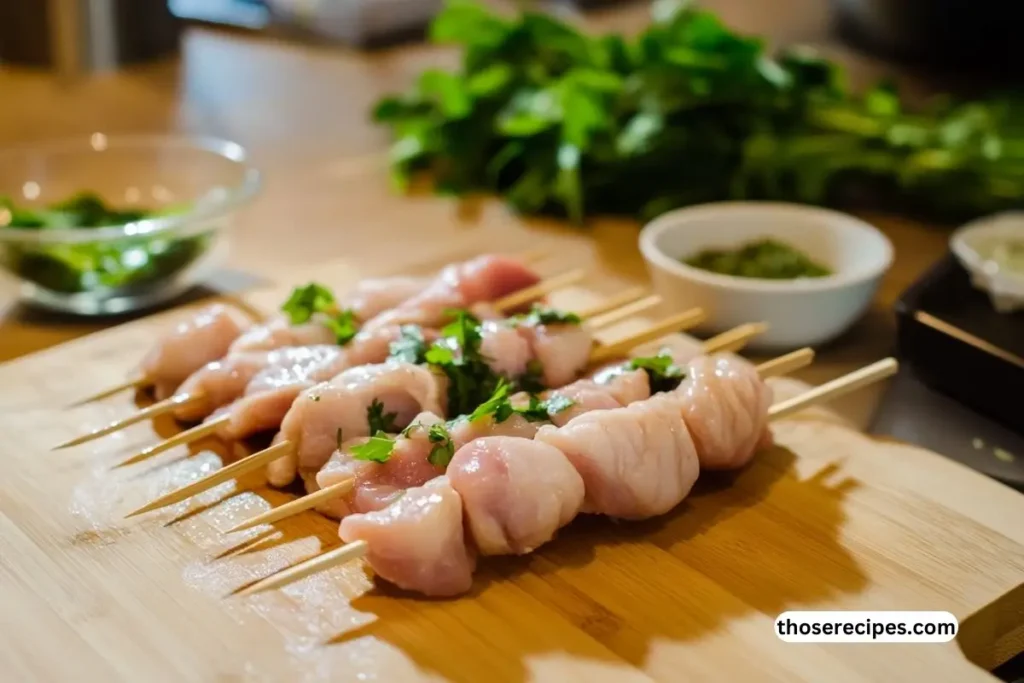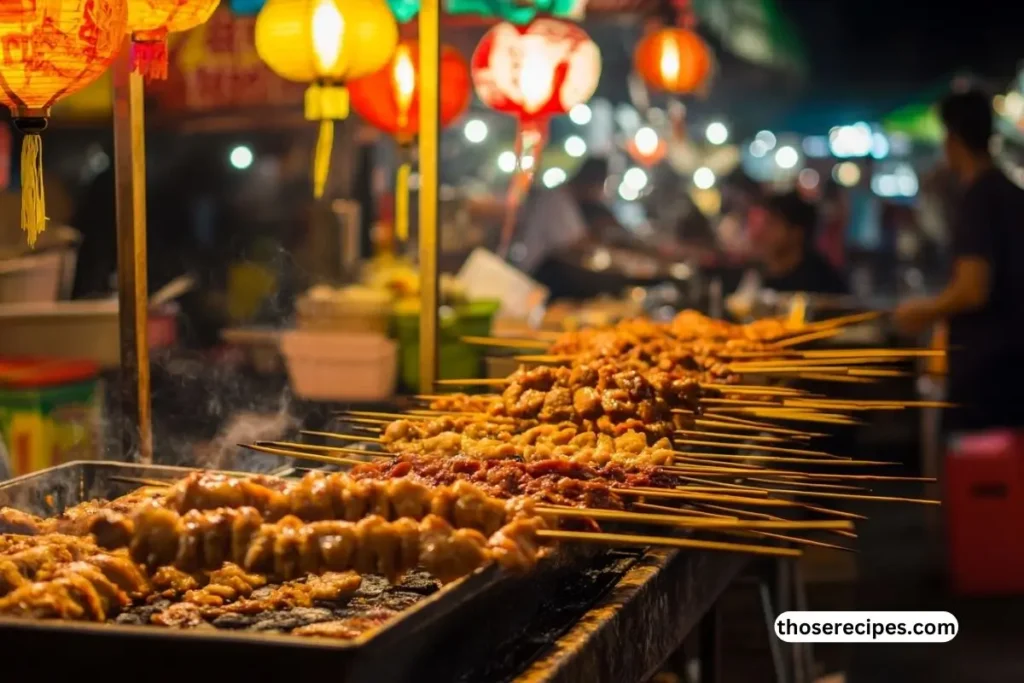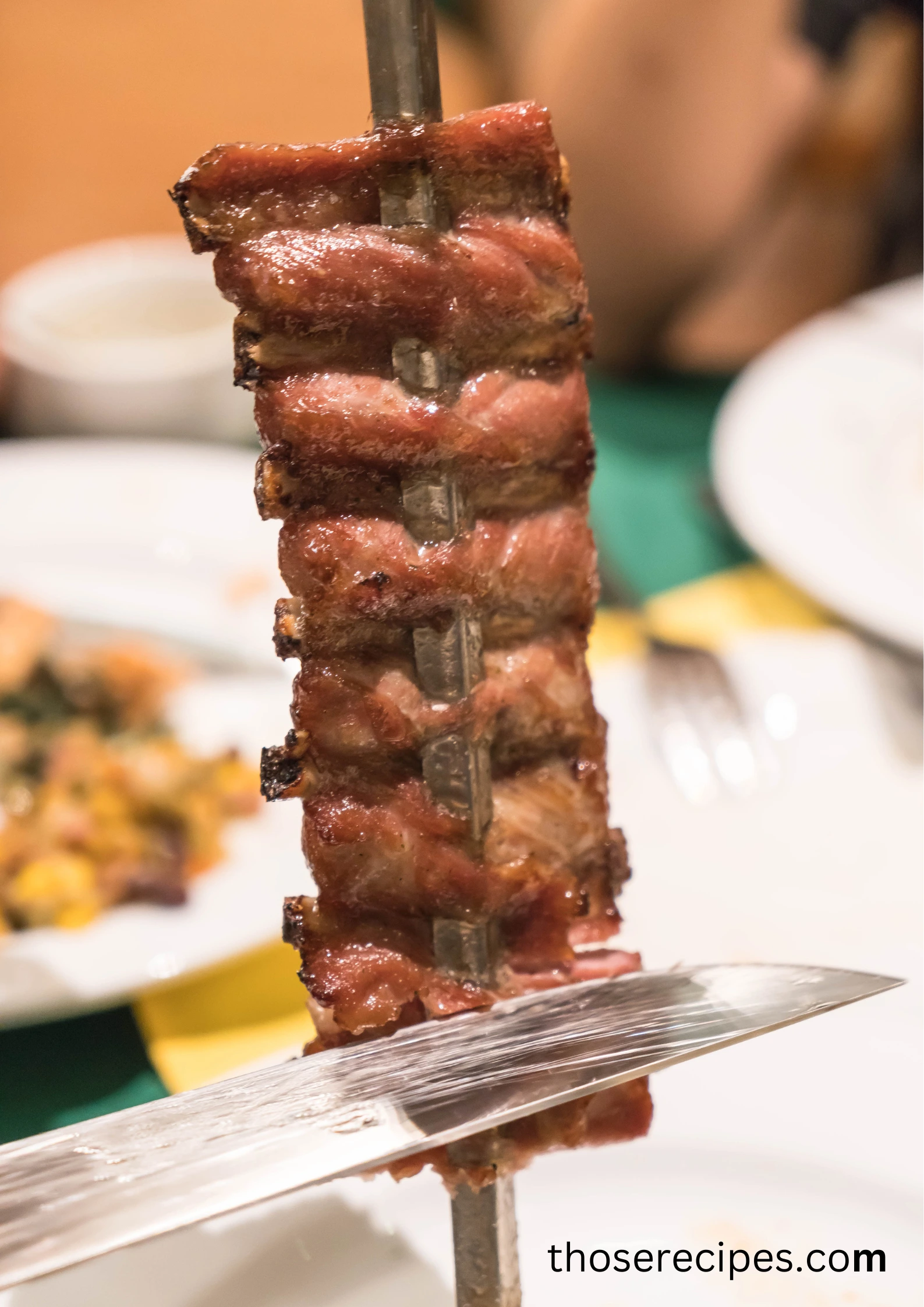Table of Contents
Discover the Irresistible World of Asian Street Meat
Imagine walking down a vibrant, bustling street in Bangkok, the air rich with the smoky scent of sizzling meats on an open flame. The sound of skewers being flipped, the sizzle as the juices hit the grill, and the laughter of people enjoying their meals fill the air. You pause at a stall where the vendor hands you a perfectly grilled chicken skewer, coated in a rich, savory marinade. As you take a bite, the flavors explode in your mouth — sweet, salty, and smoky all at once.
Why You Should Care About Asian Street Meat
- Authentic Flavors: Every bite offers a glimpse into the history and culture of its region.
- Accessible and Affordable: Street vendors provide gourmet experiences without the hefty price tag.
- Variety: From sweet satay in Indonesia to spicy kebabs in India, there’s always something new to try.
How to Make Your Own Asian Street Meat
If you’re inspired to bring the flavors of asian street meat asia into your own kitchen, you’re in for a treat. With a few key ingredients, the right tools, and some tried-and-true techniques, you can recreate the authentic tastes of Asia’s street markets. This section will guide you through the equipment, techniques, and a classic recipe to help you master the art of Asian street meat.

Essential Equipment and Techniques
Creating authentic asian street meat asia dishes starts with the right equipment and an understanding of basic cooking techniques. Here’s what you’ll need:
- Grill or Charcoal BBQ: The smoky flavor from an open flame is a hallmark of many Asian street meat dishes. If you don’t have access to a grill, a grill pan can work in a pinch.
- Skewers: Bamboo or metal skewers are essential for dishes like satay, yakitori, and seekh kebabs. Soak bamboo skewers in water before grilling to prevent them from burning.
- Mortar and Pestle or Blender: Many marinades and spice pastes require grinding fresh ingredients like garlic, lemongrass, and ginger. A mortar and pestle or a food processor will do the trick.
- Basting Brush: A simple basting brush helps you apply marinades or sauces while grilling, ensuring a flavorful glaze.
Step-by-Step Recipe for Authentic Chicken Satay
Ingredients:
- 500g chicken breast or thigh, cut into bite-sized pieces
- 2 tablespoons soy sauce
- 1 stalk lemongrass, finely chopped
- 3 cloves garlic, minced
- 1 tablespoon palm sugar
- 1 cup coconut milk
- Bamboo skewers (soaked in water for 30 minutes)

Instructions:
- Prepare the Marinade: In a bowl, mix soy sauce, lemongrass, garlic, palm sugar, and coconut milk. Add the chicken pieces and coat them thoroughly. Cover and let marinate for at least 2 hours (overnight for best results).
- Skewer the Chicken: Thread the marinated chicken onto the soaked skewers.
- Grill the Skewers: Preheat your grill or grill pan. Cook the skewers on medium heat, turning every 2-3 minutes until the chicken is cooked through and slightly charred.
- Serve: Pair the satay with a side of peanut sauce and cucumber salad for a complete meal.
Variations to Try at Home
- Meat Alternatives: Swap chicken for beef, lamb, or even tofu for a vegetarian twist.
- Regional Twists: Use different marinades inspired by other regions, like a miso glaze for a Japanese twist or yogurt-based marinade for an Indian flavor.
- Spice Levels: Adjust chili or garlic quantities based on your heat preference.
Bringing asian street meat asia into your kitchen is not only delicious but also a way to connect with the rich culinary heritage of Asia. Whether you’re hosting a barbecue or preparing a weeknight dinner, these flavors are sure to impress.
Ingredients Breakdown for Popular Street Meat Dishes
Understanding the key ingredients used in asian street meat asia will help you appreciate the complexity of flavors that make these dishes so memorable. From marinades to dipping sauces, every element plays a role in creating the iconic taste of Asian street food. Let’s dive into the essential ingredients that define these beloved dishes.
Essential Ingredients in Asian Street Meat
| Ingredient | Role in Street Meat | Example Dish |
| Soy Sauce | Adds a salty, umami depth to marinades | Yakitori (Japan) |
| Lemongrass | Provides citrusy, aromatic flavor | Satay (Indonesia) |
| Fish Sauce | Enhances savory flavors with a salty tang | Moo Ping (Thailand) |
| Garlic | Offers bold, pungent notes to marinades | Seekh Kebabs (India) |
| Coconut Milk | Adds richness and creaminess | Malaysian Satay |
| Ginger | Brings a warm, spicy kick to marinades | Korean Bulgogi |
| Palm Sugar | Balances spice with sweetness | Moo Ping (Thailand) |
How Ingredients Define Regional Dishes
The ingredients in asian street meat asia vary by region, reflecting local climates and cultural influences. For instance, lemongrass and coconut milk dominate Southeast Asian recipes, while soy sauce and sesame oil are key in East Asian dishes. This diversity in ingredients ensures a rich culinary experience that is unique to every country in Asia.
Popular Types of Street Meat in Asia
One of the best ways to explore asian street meat asia is by discovering its remarkable variety. Each region, from Southeast Asia to South Asia, has its own iconic dishes that reflect its unique culinary identity. In this section, you’ll journey through the flavors of Asia, learning about the best street meat specialties that have captivated locals and visitors alike.

Southeast Asia’s Iconic Street Meat Dishes
When it comes to asian street meat asia, Southeast Asia stands out for its unparalleled diversity and bold flavors. Here, grilled meats are often marinated in fragrant spices and served with rich dipping sauces.
- Satay (Indonesia, Malaysia, Singapore): Satay is the quintessential street meat of Southeast Asia. Skewers of chicken, beef, or lamb are marinated in a blend of turmeric, lemongrass, garlic, and coconut milk before being grilled over an open flame. The result is tender, smoky meat served with a creamy peanut dipping sauce. It’s a staple at night markets across the region.
- Moo Ping (Thailand): Thai grilled pork skewers, or Moo Ping, are another favorite. The marinade typically includes fish sauce, garlic, cilantro root, and palm sugar, giving the meat a savory-sweet flavor. These skewers are grilled to caramelized perfection and often paired with sticky rice.
East Asia’s Street Meat Staples
East Asia brings its own distinct twist to asian street meat asia, focusing on precise techniques and balance of flavors.
- Yakitori (Japan): Japan’s contribution to street meat is the beloved yakitori. These skewers feature small cuts of chicken, ranging from thigh meat to liver, grilled over high heat. The meat is often brushed with a soy-based tare sauce for a glossy, savory finish.
- Korean Bulgogi BBQ: While bulgogi is traditionally cooked at sit-down restaurants, Korean street food vendors have made it accessible on the go. Thinly sliced beef marinated in soy sauce, sesame oil, and sugar is grilled and served with lettuce wraps or as a filling for sandwiches.
South Asia’s Flavors
South Asia’s contribution to asian street meat asia is marked by its bold spices and fiery marinades.
- Seekh Kebabs (India and Pakistan): These skewers of ground meat (usually lamb or chicken) are seasoned with a blend of spices, including cumin, coriander, and chili powder, then grilled over a flame. Seekh kebabs are served with mint chutney and naan for a satisfying meal.
- Shami Kebabs (Bangladesh): Similar to seekh kebabs but made with minced beef or mutton, shami kebabs are pan-fried until golden. These flavorful patties are often sold at street stalls and paired with a squeeze of lime.
Lesser-Known Gems from Asia’s Streets
In addition to the well-known dishes, asian street meat asia features many hidden treasures that deserve the spotlight.
- Inasal (Philippines): Chicken inasal, marinated in vinegar, calamansi, and annatto oil, is a street food classic in the Philippines. Its tangy flavor and vibrant color make it a standout.
- Ping Pa (Laos): Laos offers Ping Pa, a grilled fish dish that is marinated in herbs and served on a stick. Though less common than meat-based street food, its flavor is unforgettable.
- Bo La Lot (Vietnam): This dish consists of ground beef wrapped in wild betel leaves and grilled over charcoal. Its herbal aroma and juicy filling make it a street food favorite.
The Common Thread: Flavor and Accessibility
What ties these dishes together in the tapestry of asian street meat asia is their accessibility and depth of flavor. Street meat is made to be enjoyed by everyone, from locals looking for a quick meal to travelers seeking an authentic taste of the region. The diversity in cooking styles and ingredients reflects Asia’s rich cultural heritage while catering to a universal love of good food.
Street Meat Tips and Variations
Making asian street meat asia at home can feel like a culinary adventure, but there are always ways to elevate your experience. Whether you’re looking to perfect your grilling technique, experiment with variations, or cater to dietary preferences, this section offers tips and ideas to help you recreate the vibrant flavors of Asian street food.
Tips for Perfect Street Meat
- Marination Is Key: The secret to the bold flavors of asian street meat asia lies in its marinades. Allow your meat to soak in the marinade for at least two hours, but overnight is even better for deep, complex flavors.
- Preheat Your Grill: Ensure your grill or grill pan is properly preheated before placing the skewers. This step creates that signature char and prevents sticking.
- Baste Regularly: Keep your meat juicy and flavorful by brushing it with extra marinade or a glaze while cooking. This step ensures each bite is packed with flavor.
- Cut Meat Evenly: For consistent cooking, cut your meat into uniform pieces. This helps avoid overcooking smaller chunks or undercooking larger ones.
- Use Fresh Ingredients: Fresh herbs, spices, and aromatics are crucial for authentic flavors. Avoid using dried substitutes for key ingredients like lemongrass or ginger.
Variations to Explore
- Vegan Alternatives: If you’re catering to vegetarian or vegan guests, tofu, tempeh, or even jackfruit make excellent substitutes for meat. Marinate them with the same blends used in traditional street meat recipes.
- Fusion Twists: Experiment with cross-cultural flavors, like adding Korean gochujang to a satay marinade for a spicy-sweet kick or using teriyaki glaze for a Japanese-inspired twist.
- Seafood Options: Don’t limit yourself to land-based proteins. Shrimp, scallops, and even squid work beautifully with marinades and grilling techniques from asian street meat asia.
Experimentation Is Part of the Fun
The beauty of asian street meat asia is its versatility. You can adapt it to suit your tastes, incorporate new flavors, or tailor it to fit dietary restrictions. These tips and variations ensure that no matter how you approach it, the result is always delicious.
For a deeper dive into the origins and recipes of Asian dishes, check out this guide to ancient culinary traditions, which highlights how history influences modern street food.
Looking for inspiration? Explore this collection of easy, flavorful recipes, like chicken dishes from around the world, and let your culinary adventure begin.
What Is Asian Street Meat?
When you think of asian street meat asia, you’re tapping into a vibrant and historic culinary tradition. Across Asia, street meat is more than just food—it’s an experience that combines the bold flavors of local cuisine with the energy and culture of the region. Street vendors have perfected the art of grilling, frying, and marinating meats, offering dishes that are both affordable and incredibly delicious. Whether it’s a quick skewer at a bustling night market or a savory snack from a roadside vendor, these dishes are a staple of Asian street food culture.

The Cultural Significance of Street Meat in Asia
Street meat plays an essential role in Asian society. For centuries, street food has served as a gathering point, where locals and travelers bond over shared meals. It’s not just about eating; it’s about experiencing the traditions and stories behind each dish. For example, Thai cuisine is renowned for balancing sweet, salty, sour, and spicy flavors, as seen in dishes like Moo Ping (grilled pork skewers). Beyond meat, many street food vendors also serve popular snacks like samosas, a savory pastry filled with spiced meat or vegetables. Learn more about the history and variations of samosas here on Wikipedia, and see how these dishes reflect the region’s culinary ingenuity.
Why Street Meat Is Iconic in Asia
The popularity of asian street meat asia stems from its diversity and accessibility. Every country offers its unique take on grilled or skewered meat, incorporating local spices, marinades, and cooking methods. From the smoky charcoal grills of Japan to the spicy roadside kebabs of India, street meat represents the perfect harmony of flavor, tradition, and convenience. Unlike elaborate restaurant meals, street meat is often cooked fresh in front of you, guaranteeing an authentic, mouthwatering experience.
Storing and Reheating Street Meat
Once you’ve mastered the art of preparing asian street meat asia, it’s essential to know how to store and reheat leftovers properly. Whether you’re saving skewers for a quick lunch or planning ahead for a barbecue, these tips will help maintain the flavor and texture of your street meat dishes.
How to Store Asian Street Meat
Proper storage ensures that the vibrant flavors and textures of asian street meat asia remain intact.
- Cool Before Storing: Allow the cooked meat to cool to room temperature before storing it. This prevents condensation, which can make the meat soggy.
- Use Airtight Containers: Store the meat in airtight containers or resealable bags to lock in moisture and prevent contamination. For marinaded but uncooked meat, separate it into portion-sized packages to make future meals easier.
- Refrigeration: Place cooked street meat in the refrigerator within two hours of cooking. It can be stored safely for up to three days.
- Freezing: For longer storage, freeze the meat. Wrap each skewer in plastic wrap or foil, then place them in a freezer-safe bag. Properly frozen street meat can last up to three months.
Best Methods for Reheating
Reheating asian street meat asia can be tricky, as you’ll want to retain the juicy, flavorful qualities that make it so appealing. Here’s how to do it right:
- Grill or Pan: Reheat skewers on a grill or in a grill pan over medium heat. Brush the meat with a little oil or leftover marinade to keep it moist.
- Oven: Preheat your oven to 350°F (175°C). Place the skewers on a baking sheet lined with foil and reheat for 8-10 minutes. Flip halfway through for even warming.
- Microwave: While not ideal for preserving texture, the microwave can work in a pinch. Use a microwave-safe dish and cover the skewers with a damp paper towel to prevent drying out. Heat in 30-second intervals.
Tips for Maintaining Freshness
- Avoid Overcooking: When reheating, avoid high heat or prolonged cooking times, as this can dry out the meat.
- Revive with Sauce: Drizzle reheated meat with fresh dipping sauce or marinade to restore its original flavor.
Proper storage and reheating techniques ensure you can enjoy the delicious flavors of asian street meat asia even after the first serving.

Asian Street Meat: A Flavorful Journey Through Asia’s Best Street Food
Equipment
- Grill or Charcoal BBQ
- Skewers (Bamboo or Metal)
- Mortar and Pestle or Blender
- Basting Brush
Ingredients
- Soy Sauce
- Lemongrass
- Fish Sauce
- Garlic
- Coconut Milk
- Palm Sugar
- Ginger
- Spices (e.g., Cumin, Coriander, Chili Powder)
Instructions
- Prepare the marinade by mixing ingredients like soy sauce, lemongrass, garlic, and coconut milk.
- Marinate your choice of meat (e.g., chicken, beef, lamb) for at least 2 hours or overnight for best flavor.
- Skewer the marinated meat onto bamboo or metal skewers, ensuring they are evenly spaced.
- Preheat your grill or grill pan to medium heat. Grill the skewers, turning every few minutes until cooked through and slightly charred.
- Serve the skewers with a side of peanut sauce, cucumber salad, or other accompaniments of your choice.
Notes
FAQs About Asian Street Meat Asia
As you explore the exciting world of asian street meat asia, you may have a few questions about its preparation, cultural significance, and flavors. In this section, we’ll address some of the most common inquiries to help you dive deeper into this vibrant culinary tradition.
What Makes Asian Street Meat Unique?
Asian street meat is defined by its bold marinades, smoky grilling techniques, and the cultural diversity it represents. Each country infuses its own spices, sauces, and cooking methods to create dishes that are as varied as the regions themselves. The fresh ingredients and authentic preparation methods give street meat its unforgettable flavor.
Which Asian Country Is Best Known for Street Meat?
There’s no definitive answer, as asian street meat asia varies widely across the continent. Southeast Asia, with its bustling night markets in Thailand, Indonesia, and Malaysia, is particularly famous for grilled skewers like satay. Meanwhile, Japan’s yakitori and Korea’s bulgogi have gained global recognition for their unique flavors and cooking styles. Each country offers something special, making street meat an essential part of any culinary tour through Asia.
Are There Vegetarian Versions of Asian Street Meat?
Yes! While street meat traditionally focuses on grilled and skewered proteins, vegetarian variations are becoming more common. In Southeast Asia, tofu or tempeh can be marinated and grilled to replicate the flavors of classic street meat dishes. In India, paneer (a type of firm cheese) is often used in kebabs and skewers, making it a delicious alternative for non-meat eaters.
How Do You Choose the Best Meat for Grilling?
When making asian street meat asia, the choice of meat depends on the dish you’re preparing. For satay, chicken thighs or beef cuts with some fat are ideal for maintaining tenderness. Yakitori often uses chicken parts like thigh, wing, or liver, while seekh kebabs work best with ground lamb or chicken.
Can You Recreate Authentic Street Meat Flavors at Home?
Absolutely! By using fresh ingredients, authentic marinades, and proper grilling techniques, you can replicate the flavors of asian street meat asia in your own kitchen. Investing in a charcoal grill and experimenting with regional recipes will help you achieve that smoky, street-side authenticity.
This FAQ section addresses the key curiosities surrounding asian street meat asia, offering valuable insights for both seasoned cooks and newcomers.
Exploring Asian Street Meat in Person
For food lovers, experiencing asian street meat asia firsthand is an adventure that engages all the senses. The sizzling grills, vibrant markets, and intoxicating aromas of Asia’s street food scene make it a must for culinary explorers. Here’s a guide to some of the best destinations to immerse yourself in this unforgettable experience.
Top Street Food Markets for Street Meat
- Chatuchak Market, Bangkok (Thailand): Famous for its grilled pork skewers (Moo Ping) and marinated chicken satay, Chatuchak is a hotspot for authentic street meat in Thailand. Vendors here serve freshly grilled delicacies that are packed with bold, sweet, and savory flavors.
- Jalan Alor, Kuala Lumpur (Malaysia): This bustling street is renowned for its satay vendors, offering skewered meats with rich peanut sauces. The aroma of charcoal-grilled skewers fills the air as you explore the lively market.
- Tsukiji Outer Market, Tokyo (Japan): While known for seafood, this market also serves exceptional yakitori. Each skewer is expertly grilled and seasoned, showcasing Japan’s precision in culinary techniques.
Tips for Enjoying Asian Street Meat Safely
- Go for Freshly Grilled: Ensure the meat is cooked to order to avoid potential health risks.
- Observe Hygiene Standards: Look for vendors who maintain cleanliness in their preparation and handling.
- Ask Locals for Recommendations: Locals know the best and most trusted stalls, helping you find the tastiest options.
Bring the Flavors Home
If you’re inspired by the street food experience, recreate asian street meat asia in your kitchen using authentic recipes. You’ll not only enjoy the flavors but also relive the memories of vibrant markets and smoky grills.
This section inspires readers to explore the authentic flavors of asian street meat asia while offering practical tips for a memorable and safe experience.
Conclusion: Embracing the Flavors of Asian Street Meat Asia
The world of asian street meat asia is as diverse and dynamic as the continent itself. From smoky skewers sizzling over charcoal grills to tender, marinated meats infused with spices, street meat represents the heart of Asian street food culture. It’s more than just a meal—it’s a celebration of flavors, traditions, and shared experiences.
Why Asian Street Meat Captures the Heart of Food Lovers
What makes asian street meat asia so captivating is its universal appeal. Whether you’re strolling through the bustling night markets of Bangkok, savoring yakitori at a Japanese street fair, or enjoying seekh kebabs from a roadside vendor in Pakistan, the experience is unforgettable. The smoky aromas, the vibrant atmosphere, and the bold flavors combine to create a culinary journey that appeals to all your senses.
Recreating the Experience at Home
Even if you can’t visit Asia’s street markets, you can bring the essence of asian street meat asia to your own kitchen. With authentic recipes, fresh ingredients, and the right techniques, you can savor the taste of Asia no matter where you are. Experiment with different marinades, spices, and grilling methods to personalize your creations while staying true to the spirit of street food.
An Invitation to Explore
Whether you’re a seasoned traveler or a home cook looking to expand your repertoire, asian street meat asia offers something for everyone. Dive into its flavors, experiment with its recipes, and let its rich culinary traditions inspire you. Every skewer tells a story—one of culture, passion, and the joy of sharing good food.



1 thought on “Asian Street Meat Asia: A Flavorful Journey Through Asia’s Best Street Food.”